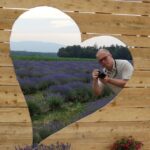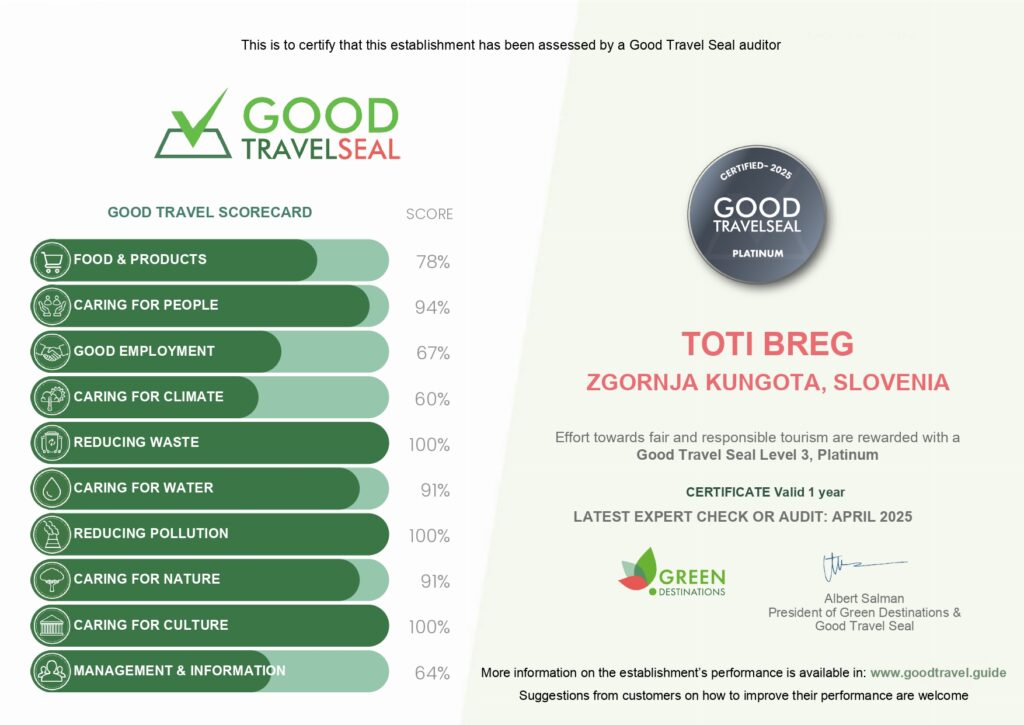Slovenia

A global, green & boutique destination for the demanding visitor.
Slovenia occupies a small corner of Europe but includes four different worlds: the Alps, the Mediterranean coastal towns, the limestone hills (karst), and the eastern plains. 60% of Slovenia is covered by forest. Over a third of the country is protected for nature conservation. This is why Slovenia sustainable tourism is flourishing. Some of the most beautiful places are still rather unknown. They offer unspoiled nature and ancient traditions, including how to make food and drinks, such as special beers and wines Learn more on the Slovenian Green Destinations, experiences and tours at www.slovenia-green.si
Not sure where to go?
Explore the options for a responsible trip
GOOD PLACES TO VISIT
Explore destinations that were certified for their sustainability efforts
GOOD TRAVEL BUSINESSES
Discover accommodations, restaurants, shops and activities that are committed to sustainability. Their efforts are summarised in a SCORECARD (click on the picture). For the Good Travel Seal, the higher the number of stars or the level (level 3 is the highest), the more aspects of sustainability are checked by an independent auditor.
- Accommodations
- Restaurants
Sunlight House Toti Breg
Good Travel Seal Level 3
Where tradition, modern lines and nature come together.
The house is situated on a sunny slope amidst vineyards around the small village of Svečina and offers unforgettable views of the wine landscape. In front of the house, you will find a generous area for a nice get-together.
The house is spacious with an open layout and is ideal for gatherings with family and friends. It offers a large living area with an oak table, fireplace and a fully equipped kitchen. On the upper level of the house, there is a large room with several beds, which is also a perfect place for workshops. Large window fronts offer unforgettable views of the valley.
GOOD PRACTICE STORIES

Get inspired with stories from places and people that are acting for a fair and responsible tourism
Bela Krajina
Bela Krajina is a typical small Slovene destination. Although on paper the destination was sustainable (Green Destination Gold), the disconnected activities and mismanagement caused consequences. The COVID-19 pandemic and government measures to assist Slovenian tourism have caused the first instances of over-tourism and negative environmental impacts. The evaluation of the offers and destination management revealed that it is necessary to start developing and managing tourism more strategically and above all more guided. The first step was to establish a destination management organization. With the significant engagement of all stakeholders, including developers, tourism providers, financiers, and the local population, a new tourism strategy was adopted.
Brežice
In the picturesque region of Slovenia, Brezice offers a diversity of tourist attractions , from thermal springs, and majestic castles to vibrant summer festivals. Since 2014, the rising number of visitors brought increased waste causing inhabitants in-satisfaction and jeopardizing the reputation of the destination, prompting to commit to sustainable events and achieve zero waste certification. The city promenade event has become a model for sustainable practices , from promoting green mobility, to reducing waste and raising environmental awareness among locals, businesses and visitors, to align with the European green policies.
Jeruzalem
Dispersed Hotel Jeruzalem Slovenia is an innovative approach that brings together a network of local accommodations spread across the picturesque landscape, offering guests an immersive experience of the region’s charm and beauty. Due to the increased popularity of Jeruzalem Slovenia as a tourism destination the issue of limited capacity rose. This challenge led the community to get creative and work together, transforming their weekend houses, and tourist farms into cozy ‘’homes’’ for guests. Involved parties united with a common goal, set out to show off the destination and promote it even better. They organized regular meetings to share insights and strategies, ensuring that every guest, no matter where they stayed, would enjoy the same special standards and warm hospitality.
The Dispersed Hotel Jeruzalem Slovenija hospitality model is a great example of how collaboration and a shared vision can elevate a destination. By networking and promoting together, the providers have created a seamless and enchanting experience for visitors.
Ljubljana
To tackle the issue of tourism seasonality in the city of Ljubljana and extend the tourism season throughout the winter months, Ljubljana City came up with an idea to organize a culturally enriched experience for cultural omnivores and hopeless romantics. The ”LUV festival” which draws inspiration from the romantic image of the Slovenian capital and links love, art, and rambling, takes place in the typically low tourism season months – February and March, hence promoting Ljubljana as a tourism destination which is wort visiting all year long.
Miren Kras
Nova Gorica on the Slovenian side and Gorizia on the Italian side have seeked out cultural and culturally related content to create cross-border partnership projects that will pave the way for sustainable cultural and tourist stories. With this promising start, an international project, SOUNDS OF PEACE was created in collaboration with numerous associations on both sides of the border (Tourist Associations, Guides Associations, Caving Associations), and tourism service providers. The event, which uniquely combines the historical, natural, and cultural heritage of the cross-border area and is conducted bilingually, includes a two-day hike along the Walk of Peace through the Slovenian and Italian Karst (Cerje and the Valley of Bersaglieri near Sei Busi – Ronchi hill). Every year, the project is enriched with two concerts by world-renowned musicians who come from both sides of the border.
Rogla - Pohorje
Climate change strongly impacts the tourism sector, including Rogla, a popular ski resort located at an altitude of 1517 meters. The snow cover is already decreasing, leading to fewer skiing days. Rogla is classified as a mid-altitude winter sports center, where there should still be prudent investment in winter sports tourism and technical snowmaking as a strategy to adapt to winters with a lack of natural snow, while also experiencing accelerated focus on year-round tourism, particularly dominant in the summer. In 2023, the Rogla ski resort began a sustainable transformation, which is an excellent example of successful adaptation to climate change. With this development, they enabled year-round tourism.
Sustainability
In 2016, Slovenia was recognised by Green Destinations as the worlds first green country destination. This is the result of hard work by the Slovenian Tourist Board (STB).
Travel tips from our editors
Getting there
There are three international airports in Slovenia, but heading to Slovenia can be more sustainable and simple. Direct trains connect the biggest Slovenian cities with important towns of all neighbouring countries. You can also reach Slovenia with international long-distance buses that connect larger European cities. You can even board a catamaran between Venice and Koper.
Getting around
Trains will take you to most of the bigger cities in Slovenia and every part of the country is reachable by bus. One drives a car to areas that are harder to reach (using car-rent and car-share too). Ride share is used by many people to travel between different parts of the county. On top of that, some towns also have bike-share and scooter-share systems.
To enjoy more of Slovenia sustainable tourism, those who are interested can also hike long distances. You can walk along the Slovenian Mountain Hiking Trail, the European Long Distance Paths E6, E7 and E12, the Way of Saint James (Camino), the Saint Martin of Tours Route, and the Alpe-Adria Trail.
Avoid over-tourism!
Still relatively unknown to wide crowds, Slovenia tries to avoid over-tourism. If you really want to visit Ljubljana and Bled, think about coming in the off-season. Or better yet, there are so many less touristic places to visit and support Slovenia sustainable tourism. They are full of urban history, natural beauty, and top service that you could explore in calm. Your senses would be thankful.
Visit our top destinations
Interested in nature and humanity? Visit Slovenia, where for ages we live and do more than just speak about sustainability. Befriend people and reveal the history of the old towns while your eyes enjoy the splendor of nature. It’s possible to enjoy Slovenia sustainable tourism in a day. However, to visit the Mediterranean region, Alps, and Pannonic plain, you might want to stay longer. Learn about the history, connect with the people, and try the regional food!
Everybody needs to eat
At the crossroads of Slavic, Germanic, and Romanesque cuisine, expect everything and more. While Michelin-starred restaurants are new in Slovenia, old village inns, mountain huts, and farm tourism pamper guests with our grandmothers’ cuisine. Don’t hold back, no one will stay hungry, and everyone will take away a satisfying experience.
Tourism & People
Slovenia has become a popular destination. This can be seen during summers in the centre of Ljubljana, in Bled, and in the northern part of Socha Valley. Hence the Slovenia Tourist board is now implementing measures to prevent over-tourism.
It is a very safe country for travellers and human rights are very well respected.
Nature & Wildlife
Slovenia’s compact size belies its incredible natural diversity. From the stunning Julian Alps to the pristine waters of Lake Bled, this country is a paradise for nature lovers. Over a third of its territory is protected, with Triglav National Park standing as the only national park. You can explore dense beech forests, hike up rocky mountain trails, and experience the vibrant biodiversity in the Soča Valley.
The country is home to rare creatures like the European brown bear, chamois, and lynx. Slovenia’s commitment to sustainability and preservation ensures that its exceptional landscapes and wildlife flourish.
Sustainability Recognitions
Slovenia was featured in the 2020 Global Top 100 Sustainable Destinations.

Other sustainability certifications can be seen here (English) and here (Portuguese).

Mrs. Maja Pak
Director of the Slovenian Tourist Board (STB)
“This pandemic has brought the biggest crisis yet in tourism, but it has also underlined the advantages of Slovenia: we have been consistently developing sustainable and responsible tourism for the last decade, and we can say that today, Slovenia has become a type of destination future travellers will be looking for, green and safe. The 2020 Sustainable Top 100 Destination Award in the category Best of Europe, that we received at this year’s ITB Berlin proves that our decision for the development of responsible tourism was the right one. We are even more proud of the fact that throughout this year, the number of members of the Green Scheme of Slovenian Tourism has grown and many businesses have expressed interest to join despite difficult circumstances. This shows that commitment to sustainability in Slovenia is wide-spread and can be found in all sectors of our tourism industry, not just on the national level. With sustainability at the core of all our activities, even at this unprecedented time, tourism will become more resilient and will recover sooner.”

Rasto Kirn
Page Editor
A researcher and gourmet at heart, registered architect and spatial planner by profession. Because of love for travel and his wife’s profession, ventured into the tourist waters. Active in the initial stages of tourism project development. Based in Maribor, the second-largest city in Slovenia. Presents his region on social media, calling Maribor the foodie capital of Slovenia based on his own international experience.
Visit other destinations nearby?
Get in touch
Support
We are a multicultural, creative and dedicated team working to promote sustainable tourism. Join us in our fight against the climate crisis, single-use plastics and over-tourism!


